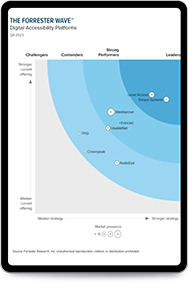VPAT
Feb 13, 2024
To comply with federal laws, organizations must deliver software products and platforms that are accessible to people with disabilities. And now, due to the evolving legal and regulatory landscape, documentation is required to prove this conformance with accessibility standards. This is where the VPAT®, a Voluntary Product Accessibility Template, is used.
What is a VPAT?
A VPAT is a standardized document that evaluates a product’s level of conformance with digital accessibility guidelines. Created by the Information Technology Industry Council (ITI), VPATs were originally intended for companies who contracted with government agencies to demonstrate compliance with Section 508 of the U.S. Rehabilitation Act. However, since proven successful at the federal level, VPATs have gained global recognition and are now used in both the public and private sector.
The VPAT offers a structured format for vendors to outline the extent to which their information and communication technology (ICT) products meet accessibility standards. This includes any hardware, software, or electronic content used in procurement. As part of the software sales process, sellers of these digital products must provide a completed VPAT, otherwise known as an Accessibility Conformance Report (ACR).
What’s included in a VPAT?
The ITI created four different editions of the VPAT to help ICT manufacturers create ACRs that are relevant to their target market:
- VPAT 2.5 Rev 508: Revised Section 508 Standards — the U.S. Federal accessibility standard
- VPAT 2.5 Rev EU: EN 301 549 — the European Union’s accessibility requirements
- VPAT 2.5 Rev WCAG: WCAG 2.2
- VPAT 2.5 INT: Incorporates all three of the above standards
Although tailored to different audiences, each edition of the VPAT contains the following information:
- Instructions and best practices for using the VPAT to ensure comprehensive and consistent reporting by manufacturers.
- A “Product Description” field for a brief overview of the product.
- An “Evaluation Methods Used” field to describe the accessibility testing methods used.
- A “Notes” field for additional information about the product tested and evaluation methods.
Why are VPATs important?
Utilizing VPATs can not only demonstrate a product’s accessibility conformance but can enhance brand reputation. Diversity and inclusion have become crucial brand values for customers, which is why they expect software products to prioritize accessibility. Building a reputation for accessibility through completed VPATs will boost customer loyalty.
Committing to accessibility and incorporating it into the procurement process will allow organizations to stand out in their industry. With a completed VPAT, organizations involved in the software sales process are reassured that a product adheres to accessibility guidelines and legal requirements.
Due to its complex nature, completing a VPAT will require assistance from a digital accessibility expert. To learn more about how to complete a VPAT, check out this blog for an in-depth overview on VPATs and ACRs: What is a VPAT? What You Need to Know About VPATs & ACRs.
